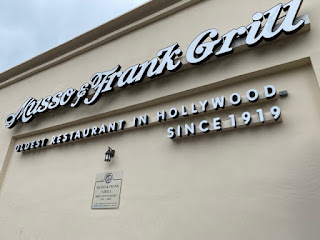Week 238: Hollywood Boulevard History
May 30, 202110,000 Steps a Day in L.A. #16: "Hiding in Plain Sight," 3.45 miles.
Paul Haddad called this an "anti-tourist" walk. That it is, especially if—like Barbara and I did—you take this hike early on a Sunday morning before the souvenir and lingerie shops open and the tourists and vagrants show up. And if you keep your feet on the star-studded Walk of Fame and your eyes up instead of forward or down, you'll experience the growth of Hollywood Boulevard from the end of WWI to the start of the Great Depression and then some. After Prospect Avenue was renamed Hollywood Boulevard in 1910, developer Charles E. Toberman, the "Father of Hollywood," began to envision a theater district and regional shopping district. Enter the 1920s: the Jazz Age, flappers, the silents-to-talkies transition, Prohibition, Hollywood royalty, and the Golden Era of Los Angeles architecture. Toberman and a string of famous architects brought Hollywood Boulevard alive with brand new movie theaters, nightclubs, hotels, and office buildings in a panoply of architectural styles. The entire district is on the US Register of Historic Places and nearly every old building is a L.A. Historic-Cultural Landmark. Barbara and I started at Argyle Avenue and walked west with an eye on the golden pharaohs looking down on us from the cornice of the Pantages Theater. Built in 1930 as an Art Deco vaudeville house, it transitioned to movies then stage productions. Howard Hughes made his office on the second floor in 1949 (ghost rumors unfounded.) At the NE corner of Hollywood and Vine, the 1929 Late Gothic-Art Deco Equitable Building, a 12-floor attempt to "metropolitanize" Hollywood, has a cast of corbels staring down from the edges. Quick side trip up Vine for a look-see at the Avalon, the 1927 Spanish Baroque etched with goat men and sphinxes around the entrance. It opened as the Hollywood Playhouse, lived several media lives and in 1978 became the we've-all-been-there music venue, The Palace. Back to Hollywood Blvd. and the former Warner Bros. Hollywood Theater, a Gothic structure edged with 75 faces. Built in 1928, it had a ballroom on the second floor, the KFWB radio tower on top, and an ice rink in the basement. Steps past Cherokee, Musso & Frank opened in 1919 and still serves the best chicken pot pie/martini lunch in the city. (Chandler wrote there, Chaplin had his own booth.) But three movie palaces on the Boulevard define the area and the era. The first, the Egyptian Theater, built on the south side of the boulevard, opened in 1922 with the premier of ROBIN HOOD. Why Egyptian Revival architecture? Howard Carver was excavating the Valley of Kings at the time and the nation was curious. He found King Tut two weeks after the Egyptian opened! At the NE corner of Hollywood & Highland is the Hollywood First National Bank. When it was built in 1927 it had a moment as the tallest hi-rise in LA, an Art Deco-Gothic "economics temple" with gargoyles and corbels of Columbus and Copernicus. The NW corner is the Hollywood & Highland complex (2001) on the site of the old, 1902, Hollywood Hotel. The Dolby Theater hosts the Academy Awards, and the red carpet path to the theater is edged with pillars listing every Best Picture since the origin of the Oscars. Across the street, the second iconic movie palace, the El Capitan, built in 1926 in California Churrigueresque/Spanish Baroque style. "Hollywood's first Home of Spoken Drama," the El Capitan hosted the premier of Citizen Kane in 1941. Disney bought the theater in the late 80s, and premieres all of its movies there. Kimmel tapes next door at the Masonic Lodge, a Neoclassical temple built in 1921. Next stop, the third iconic movie palace, the Chinese Theater. Built in 1926 to resemble a Chinese pagoda, it sits on the site of the former Francis X. Bushman mansion. Conflicting stories about how the cement hand- and footprint tradition got started, but my favorite is the one where Norma Talmadge accidentally stepped in cement. We took a side trip up Orange Drive to see the Nirvana, a 1925, Oriental Revival apartment complex with a dragon above the front entrance. A terrific street to make our turnaround—at the north end, the Magic Castle, known to us as the 1909 Lane House, built at the birth of Hollywood. At the south end of Orange on Hollywood Blvd., the 1927 Hollywood Roosevelt Hotel, the oldest continually operating hotel in LA. Gable and Lombard rented a suite there for $5/night. On our walk back, three fun stops. A different view of the staircase to the Hollywood & Highland complex and its courtyard archway inspired by DW Griffith's 1916 movie Intolerance, that beautifully frames the Hollywood sign in the hills beyond. At Hollywood and Vine, the Broadway Department store built in 1927. Sure it's a historic landmark, but even more so because Barbara worked there as a "Hi-Deb" when she was in high school. The Walk of Fame didn't begin until 1958, and as of today there are 2,690 stars. It felt like we walked over most of them on this hike, but my favorite was Rochelle Hudson's star at 6200 Hollywood Blvd. Family legend has it that my dad named me after her because the star resembled my mom. I like that. Great walk back in time to how the boulevard became the symbol of old Hollywood.





































0 comments